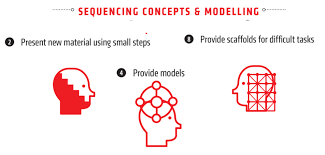Strand 1: Sequencing Concepts and Modeling
Strand 1, also referred to as Sequencing Concepts and Modeling, is an important collection of practices that take place in the “advanced planning” stages of classroom instruction (Sherrington, 2019). For this reason, it makes natural sense to start with these practices and consider them as having a dramatic impact on lesson design before even entering the classroom. Strand 1 contains three Practices, including:
Practice #2: Present new material using small steps
Practice #4: Provide models
Practice #8: Provide scaffolds for difficult tasks
In relation to these practices, which we will further investigate, there are a few overarching instructional guidelines to consider (Sherrington, 2019):
- After presenting information in small steps, instructors should also provide students with an opportunity to practice.
- Teachers should limit the amount of information students receive at one time, specifically consider their zone of proximal development, or ZPD (Vygotsky, 1978).
- Make sure instructions and explanations are clear and detailed.
- Provide a think-out-loud narration for students while showing them a model.
- Effective class, or exposure, time is used when sharing additional models and explanations.
- Provide even more models.
- Re teach material, with new explanations and models, when needed.

Within this section we will address the following learning intentions…
Learning Intentions: By the end of this section, participants will…
- Understand the importance of presenting new information in small steps and explore an overview of this practice through the Gradual Release Framework (specifically addressing “focused instruction” and “guided practice”).
- Learn a variety of modeling techniques and how their use enhances explanations.
- Investigate and develop knowledge of effective, instructional scaffolding to support students as they move to independence.
Please continue to Practice #2: Present new material using small steps…


